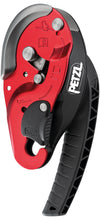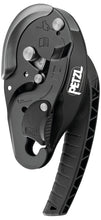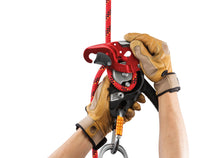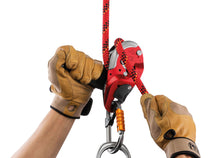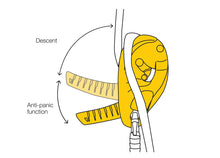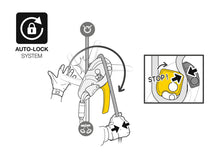
Petzl I’D L
Self-braking descender with anti-panic function for technical rescue
The I’D L self-braking descender is primarily designed for technical rescue. It has an ergonomic handle that allows comfortable descent control. The integrated anti-panic function and anti-error catch limit the risk of an accident due to user error. The AUTO-LOCK system allows users to position themselves without having to manipulate the handle or tie off the device. Once locked, the rope can be taken up without having to manipulate the handle. The safety gate allows the rope to be installed with the device remaining connected to the harness. I'D L is compatible with 12.5 to 13 mm ropes and allows handling of loads up to 280 kg.
- Designed for technical rescue
- Easy to use:
- safety gate on the moving side plate allows the rope to be installed easily while the device remains connected to the harness
- easy rope installation, thanks to the rope guide and markings
- anti-error catch to reduce the risk of an accident due to incorrect installation of the device on the rope
- ergonomic handle allows the rope to be released and enables comfortable control of the descent. Two possible descent modes: on the side plate or in the V-shaped friction channel
- anti-panic function automatically stops the descent if the user pulls too hard on the handle
- allows smooth movement along inclined or horizontal terrain
- AUTO-LOCK system allows users to position themselves without having to manipulate the handle or tie off the device: as soon as the user releases the handle, the rope is automatically locked in the device. The automatic return system on the handle limits the risk of the device getting accidentally snagged
- handle automatically switches to storage position when the rope is removed from the device, reducing the risk of accidental snagging when the descender is carried on the harness - Versatile:
- once locked, the rope can be taken up without having to manipulate the handle, for making a reversible haul system or for easy short ascents, for example
- cam can be manipulated for feeding out slack easily or for belaying a lead using climbing techniques
- the moving side plate locks with a screw, allowing the I’D L to be integrated into rescue kits
- a second brake, open or closed, may be added to improve descent control depending on the weight and rope diameter - The stainless steel wear plate improves durability by reinforcing the rope friction zone
- Descending a heavy load up to 280 kg
- Rope compatibility: 12.5 to 13 mm in diameter
- Available in two colors: red and black
Petzl Specifications
- Material(s): aluminum, steel, nylon
- Weight: 600 g
- Maximum working load: 280 kg (more information in the Instructions for Use and in the technical advice at www.petzl.com)
- Certification(s): EN 341 type 2 class A, CE EN 12841 type C, ANSI Z359.4, NFPA 1983 General Use, EAC - EN 341 type 2 class A when used with a VECTOR 12.5 mm rope - EN 12841 type C when used with a 12.5 to 13 mm EN 1891 A rope - ANSI Z359.4 when used with a 12.5 to 13 mm rope - NFPA 1983 General Use when used with a 12.5 to 13 mm rope
| References | D020BA00 | D020BA01 |
|---|---|---|
| Color(s) | red | black |
| Rope compatibility | 12.5 to 13 mm | 12.5 to 13 mm |
| Guarantee | 3 years | 3 years |
| Packing | 1 | 1 |
Declaration of Conformity (.pdf)

Ask the Expert: CEO Chris Koester
2019 Newly Redesigned Petzl ID’L Review
The Petzl ID”L has been redesigned for 2019. The new ID’L was released in April of this year.
The Id’l Handle
The Good
Petzl took away the button on the end of the handle. This button was to assist feeding line out in a low angle environment or to feed slack out/in when used as a belay device. The button never worked very well for either and this is a big improvement. The other feature of the handle that Petzl changed is the handle now is spring loaded. This change means that whenever a rescuer or rope access personnel let go of the handle the handle automatically springs back into lock mode. The previous version the user had to:
- Remember to move the handle to lock mode
- Move the handle to the locked position.
The 2019 ID’L handle automatically moves to the locked position when you let go of it. This is a great feature and adds another level of safety on top of all the anti-panic features already built into the Petzl ID’L.
The Bad (but really not that bad)
When loading rope into the ID’L you have to hold the now spring loaded handle to keep the cam open to insert your rope. For new users this can be like rubbing your head and patting your belly. However with the new gate feature (which we discuss in a minute) you can keep your ID’L on your carabiner and this helps make holding the spring loaded handle and inserting the rope a little easier.
The Ugly
We have nothing ugly to say about the ID’L handle we like the redesign the fact the button is gone and the we like the added safety of the handle springing into locked position any time you need to go hands free.
The Face Plate
The Good
The face plate of the newly redesigned Petzl ID”L has had a major redesign. One of our biggest pet peeves of the old ID’L (remember L stands for Large meaning you use large diameter rope because the ID’L is for rescue and meets the NFPA 1983 standard for rescue equipment for a two person load) is that it did not have a gate in the face plate. The ID’S (S is for smaller diameter rope typically the ID'S is used by Rope Access Technicians) has had a gate in the face plate for years.
We could never understand why the ID’L did not have a gate, after all, the ID’L was designed for professional rescuers and if you cannot operate it safely you probably are not a professional rescuer (if you are looking for professional training from a reputable company, we do that as well - priority1safe-t.com). The addition of the gate to the ID”L is not just good but to quote tony the tiger IT’S GREAT! This is the best feature out of all the features we will discuss in this review. A rescuer can finally use the ID'L the same way as the rope access technicians. We can keep the ID’L attached to a carabiner and open the face plate without taking the ID'L off from the carabiner to load or unload rope. To a new rescuer this might sound trivial, but for the experienced rescuer this is a huge improvement.
The rolled edge on the face plate is no longer aluminum molded with the rest of the face plate the 2019 ID’L has a stainless steel rolled edge that is attached to the face plate. The stainless steel rolled edge will hold up longer then the previous versions that had the aluminum rolled edge and the stainless will hold up to harsher conditions such as use in industrial facilities such as refineries, chemical plants, or other heavy industrial facilities. After all when your being lowered or raised or rappelling with the ID'L your rope is in contact with the rolled edge the entire time and the stainless steel edge will withstand any elements that might have made contact with your rope. The other benefit of the rolled edge is stainless will hold up better to the friction/heat generated by long lowers or rappels.
The last item to discuss is that there are two holes in the new face plate to add a closed or open friction device (Petzl calls these the Auxiliary Closed brake and Auxiliary Open Brake). This too is a good change. The closed device is if you want to permanently run the rope through it for extra friction. The open device is so you can have the option to place the rope in it for extra friction or if you want to use it to change the direction of your rope to more easily feed the rope when it tight spaces. We like having the option of adding these auxiliary brakes in particular the open brake. With the old design if you were lowering a heavy person or a two person load you used a carabiner to run your rope through for the extra friction or change of direction by adding the open brake to the ID’L you don’t have to fumble around trying to get a carabiner out of your pack or off your tool holder on your harness with the open brake attached it is there to use if you need it and you do not have to fumble around with a carabiner. We think is a great option to have on the ID'L face plate. The closed brake is also great option if you want to make it permanent so the user always uses extra friction.
The Bad
We do not feel there is anything bad with the changes the face plate.
The Ugly
We think all the changes and options to the face plate are good, but in particular we think the addition of the gate is the best change to the face plate making the ID'L much more user friendly.
The Internal Cam
The Good
The cam that the rope feeds around for friction or that presses against the rope to work hands free has been redesigned and is shaped differently. The cam design allows for the rope slack to be fed through the device more easily thus the reason they took the button off of the handle. The new cam works to make the rope feed more easily when pulling slack through when your using it as a belay device as well as pulling slack through it when preparing to lower someone over an edge. We think the new cam is a good design improvement but it is kind of difficult to get to excited about a cam.
The Bad
There is nothing bad to say about the cam re-design. We like it and it works.
The Ugly
There is nothing ugly to say about the Cam. We like that the rope feeds through easier and the fact that by changing the cam Petzl got rid of that silly button that is on the older generation ID’Ls that didn’t really work that well.
Petzl ID'L Review Conclusion
Do you have to spend a bunch of money to replace your old ID’Ls? No. If you have the older ID’L, it will work for years to come. However, the new ID'L has several benefits you can appreciate, including the gate, the auxillary brake option, and the redesigned cam. If you use your ID’L frequently either for work or training, then you should seriously consider upgrading to the new ID’L due to the 2019 improvements.
Thanks for reading be safe and remember don’t be a youtube expert. Find a quality qualified training entity to instruct you on the proper use of the ID'Ls. There is no such thing as using youtube to become an expert with rope rescue equipment and rope access equipment.






